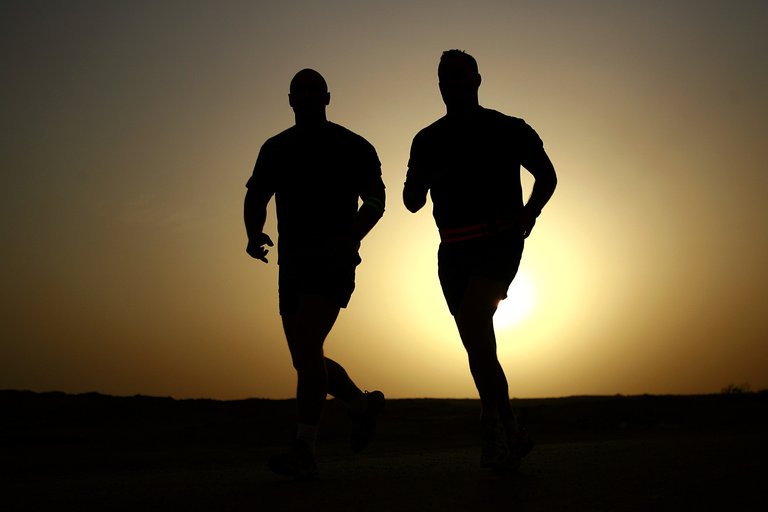
Image courtesy of pexels.com
I am not sure if you've been following my ABC's or Running, but a few days ago, I posted the letter "V" with an in depth discussion on VO2Max, and its importance. I did promise a further discussion on how to specifically train to improve your VO2Max values, so I thought it would be a great start to my first post for the @runningproject.
When it comes to VO2Max it's not the single determining factor to decide who is the better runner, but if we lined up a group of runners, the individuals who had the larger VO2Max number would generally be faster than the runners with lower values. VO2Max is the maximum amount of Oxygen an individual can consume when working as hard as you can and is a general term that we can measure how fit we are. If we improve this value, we will be able to use oxygen better and hopefully run faster.
The first way to improve your VO2Max is to lose weight
Please keep reading, cause I am not suggesting that you deliberately lose weight to improve your VO2Max. What I am saying is that, if you are using running as a way to lose weight, and its working, one of the really cool benefits of losing weight is your VO2Max will also improve. As in running, it is a weight bearing activity so if the runner is needing to use less energy to move against gravity, this has an impact on your VO2Max
Specific Run Training To Help Improve VO2Max
So we're in agreeance that improving your VO2Max will help your running performance and to improve your VO2Max, it appears the most effective way to do so is be training at levels which makes you reach your VO2Max, or in other words breathing hard. The good news is, there are a number of ways you can achieve this, so if one of the training sessions does not suit you, there are always more to choose from.
A general rule for training your VO2Max is running intervals where you need to work for 2 to 6 minutes with close to an equal amount of recovery. If you haven't had your VO2Max tested before, a general rule of thumb is any VO2Max training should be run at your similar 1 mile or 2 km race pace.
Warm Up and Cool Down
Before we do any specific training such as this, you need to make sure your body is prepared for the higher intensity pace that we need to get to for this specific training. A good warm up will usually mean, at least, ten minutes of easy running with 3 or 4 10 second strides or accelerations. Your cool down can be similar with some stretching added in instead of excelerations.
Main Set of Work
I like to perform these sessions on a running track or on a treadmill because it allows me to control the speed, distance and time that I am running for. The main set for this training run would include ONE of the following sets:
- 800m repeats at 3km race pace. The goal is to perform 6 to 8 of these sets and you should be aim to recover for a similar time that it takes you to perform the 800m repeat.
- 1000m repeats at 5km race pace. This time you need to aim for 4 to 5 repeats, again including a recovery break of a similar time it takes you to do the 1000m repeat.
- 1600m repeats at 10km race pace. Even though your body will take longer to get to your desired heart rate, you should actually be in that zone for longer with this option. Aim to complete 4, with half the time for recovery.
How Often Should You be Performing These Training Sets
This will generally be your hardest training run of the week so make sure you are performing it in between easy days or rest days. If you are training for longer runs, you should only be performing this once a week, but if you are building up to a 5km or 10km race, you could add in a second VO2Max training session for the week. You should be looking at limiting the amount of speed repeats to approximately 8% of your weekly running mileage.
For me personally, I've always found these sessions to show me where my running is actually at and currently it needs a lot of work. These are tough sessions but I always feel like I am getting a good band for my buck.

Now over two years ago, a pic of me running Ironman New Zealand
About the Author
Hey I'm Vince, an Aussie living in New Zealand, trying my best to make the most of the time I have. I work as a Software Engineer but love to run and all aspects of it, including geeking out on the latest science to help get the most out of my body.
For more information about @runningproject please see the latest status report:
https://steemit.com/runningproject/@runningproject/the-steem-running-project-new-services-available-and-6th-status-report
Also, don't forget to vote for your "Running Author of the Week"
https://steemit.com/runningproject/@runningproject/vote-your-running-author-of-the-week-the-steem-running-project-wk8-by-runningproject
Post created by @run.vince.run on behalf of @runningproject
Nice article Vince! I'd love to get a VO2MAX test done someday, but I'm not that interested that I want to pay for it. ;) As a trainer, I pretty much always prescribe this type of training for fat loss for clients who can handle the intensity, so you are right on in that it improves your body in many metrics.
A lot of people get caught up with the VO2Max values and wear it more like a badge of honor instead of using it as a tool to improve your fitness. Get a test done is pretty expensive and I don't think it is worth it compared to performing a beep test or cooper test. I was luck though, I have been able to put my hand up for some scientific studies to get them for free.
Thanks for your kind words @run.vince.run
Oh yeah, I'm not that serious. I just enjoy the science behind it. If I'm making progress in my racing performance that makes me happy enough. 😀
Very good post man!!!! Just I have added @runningproject in the title , just for attracting more runners to the initiave.
Welcome to the Authors group!
Hey @toofasteddie thanks for having me and thanks for making the change to the heading...Will make sure I keep that in next time.
Regards @run.vince.run
This is great Vince, nice article!
thanks, proud of my first @runningproject post.
Regards @run.vince.run